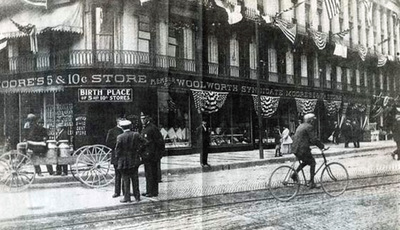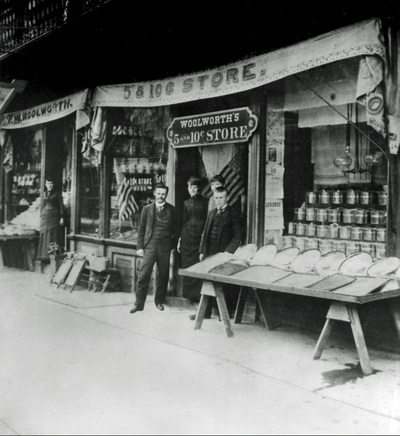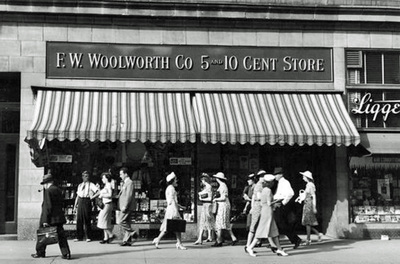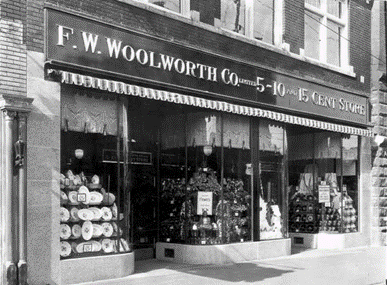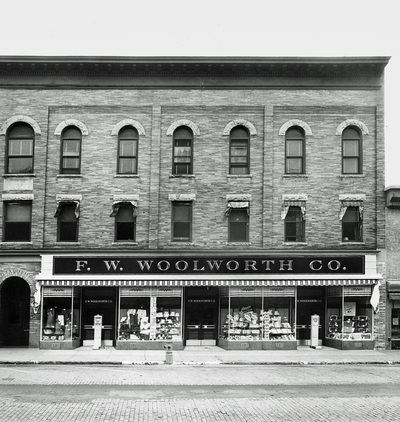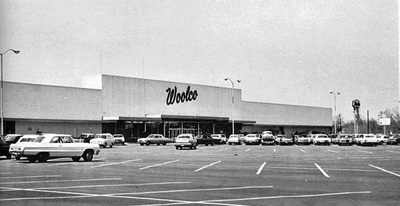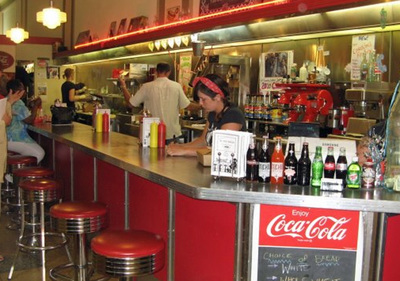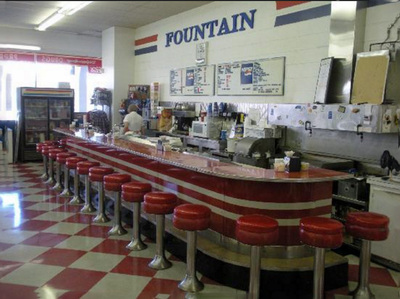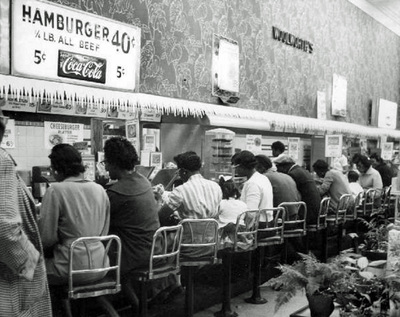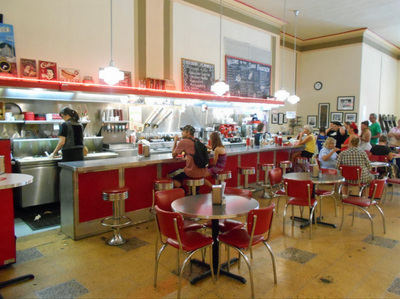The Author is Lynda Charlotte Reid Millard in collaboration with Keith Millard
Frank Winfield Woolworth was born in Rodman, New York on 13 April 1852. At the age of fifteen he gave up life on his father's farm to seek his fortune working in a shop in Watertown NY. Despite studying commerce and book-keeping at night school, his boss, William Moore, found him useless as a Shop Assistant. Instead the young man took charge of display and stock management. One of his jobs was to set up a table of fixed price five cent goods, which proved such a hit that in 1879, with Moore's support, he branched out on his own, setting up one of America's early fixed price stores.
He opened the first Woolworth store on February 22, 1878, as "Woolworth's Great Five Cent Store" in Utica, New York. Though it initially appeared to be successful, the store soon failed. When Woolworth searched for a new location, a friend suggested Lancaster, Pennsylvania. Using the sign from the Utica store, Woolworth opened his first successful "Woolworth's Great Five Cent Store" on July 18, 1879, in Lancaster. It was a great success and later the same year his younger brother, Charles Sumner Woolworth, joined as Manager of a second store in nearby Harrisburg. Ten cent lines were added in 1881, creating the first Five and Ten Cent store chain.
Over the next twenty years Frank invited relatives and co-workers from Moore's to join him, establishing a syndicate of five 'friendly rivals'. The chains operated independently, but carried his goods. The formula proved popular, allowing each pioneer to expand rapidly. The openings drew large crowds. As his buying power grew, Woolworth started to track products back to the source, offering cash payment to those vendors who were willing to drop their prices and sell direct. (Sounds somewhat like Costco today?) Many of the items came from Europe, where manufacturing was more advanced.
By 1905 other five-and-ten chains had opened in competition. Although these chains were much smaller and less successful, each of the syndicate members decided to incorporate his company, selling shares to friends and managers. This was done defensively as a safeguard against a hostile takeover, but also raised a lot of money, making the pioneers rich and allowing them to accelerate their opening programmes.
F.W. Woolworth was the retail phenomenon of the twentieth century. The mass-market shop sold factory-made goods at rock bottom prices. It was the first brand to go global, building to more than 3,000 near-identical stores across the world.
At its height it generated such riches that its Founder was able to put up the world's tallest building and pay for it in cash. Its shares were the gold standard of the New York and London markets, paying dividends that others could only dream of. To become a supplier was considered a licence to print money.
Part of its magic was an ability to adapt to fit into different local communities and to 'go native', without sacrificing its identity. Shoppers in the UK considered 'Woolies' as British as fish and chips, while Americans continued to call the chain 'the five-and-ten' more than sixty years after the limits were dropped.
But, having risen like a meteor, all the way to the top, it faded into a peaceful retirement in the USA and Canada in the 1990s.
My mother’s father, Angus Reid, was the youngest of the Picton, Ontario Reid family. Born 1887, his dad died when he was very young so his older brothers were like a father to him, particularly Walt. Angus only went to school to grade 8. When he was in his late teens his sisters encouraged him to go to business school. His teacher was skilled in penmanship and interested Dad in the new freehand style becoming popular at that time. He developed a skill which he was quite proud of all his life.
Angu was always the young kid to his brothers, due to the whole generation gap between them. Unlike his brothers he never learned the “cooper” trade (barrel making). He drove the family cow to pasture every day during summer. In his late teens he played hockey for the Picton OHA Juniors. There were the days of seven man hockey, no subs except for injury. The seventh man was called a rover and usually played between the defense and the centre. Angus played rover. The team was nick-named the "Little Men of Iron". For some league games they used to travel the 25 miles to Belleville by sleigh. They would travel along with their staunch fans all day, play hockey and come home the same night. Somewhere around 1907 they had advanced to the Ontario finals, played in Toronto against St. Mikes; they were trounced. It was the first time Dad had been past Belleville in his life.
When Angus was 20 sister Lottie, who was living in Livonia N.J. at the time, sent for him to visit her. It was his first time away other than his hockey travels. Lottie and her family encouraged him to apply for work with Woolworths. He presented himself, country hick et al, at the famous Woolworth Bldg, in New York City and asked for a job. They offered him work in Pittsburg, PA - report next week they said. He had never heard of Pittsburg, let alone knew where it was. With his sisters support he went off to Pittsburg to begin his career with Woolworths.
Woolworths moved into Canada two years later, in 1909 and Angus, being a Canadian, applied for transfer. He was sent to the main downtown Montreal store on St. Catherines St near McGill St. Shortly after he was sent to Glace Bay, N.S. as store manager. Glace Bay is near Sydney and was a coal mining town with a large Scots presence. It was also quite aloof to outsiders so he wasn't received too well. Out of boredom he went to a local dance. When one of his dancing partners asked his first name and he answered "Angus" he was immediately accepted and introduced all around. He was in Glace Bay for two years when he was sent to Saskatoon to open a new store. It was here he met my grandmother, Ellen Moxley. She was a Saturday girl who came in to the store to play the piano to sell sheet music. This was the era when "Fox Trot" music was the rage.
Frank Winfield Woolworth was born in Rodman, New York on 13 April 1852. At the age of fifteen he gave up life on his father's farm to seek his fortune working in a shop in Watertown NY. Despite studying commerce and book-keeping at night school, his boss, William Moore, found him useless as a Shop Assistant. Instead the young man took charge of display and stock management. One of his jobs was to set up a table of fixed price five cent goods, which proved such a hit that in 1879, with Moore's support, he branched out on his own, setting up one of America's early fixed price stores.
He opened the first Woolworth store on February 22, 1878, as "Woolworth's Great Five Cent Store" in Utica, New York. Though it initially appeared to be successful, the store soon failed. When Woolworth searched for a new location, a friend suggested Lancaster, Pennsylvania. Using the sign from the Utica store, Woolworth opened his first successful "Woolworth's Great Five Cent Store" on July 18, 1879, in Lancaster. It was a great success and later the same year his younger brother, Charles Sumner Woolworth, joined as Manager of a second store in nearby Harrisburg. Ten cent lines were added in 1881, creating the first Five and Ten Cent store chain.
Over the next twenty years Frank invited relatives and co-workers from Moore's to join him, establishing a syndicate of five 'friendly rivals'. The chains operated independently, but carried his goods. The formula proved popular, allowing each pioneer to expand rapidly. The openings drew large crowds. As his buying power grew, Woolworth started to track products back to the source, offering cash payment to those vendors who were willing to drop their prices and sell direct. (Sounds somewhat like Costco today?) Many of the items came from Europe, where manufacturing was more advanced.
By 1905 other five-and-ten chains had opened in competition. Although these chains were much smaller and less successful, each of the syndicate members decided to incorporate his company, selling shares to friends and managers. This was done defensively as a safeguard against a hostile takeover, but also raised a lot of money, making the pioneers rich and allowing them to accelerate their opening programmes.
F.W. Woolworth was the retail phenomenon of the twentieth century. The mass-market shop sold factory-made goods at rock bottom prices. It was the first brand to go global, building to more than 3,000 near-identical stores across the world.
At its height it generated such riches that its Founder was able to put up the world's tallest building and pay for it in cash. Its shares were the gold standard of the New York and London markets, paying dividends that others could only dream of. To become a supplier was considered a licence to print money.
Part of its magic was an ability to adapt to fit into different local communities and to 'go native', without sacrificing its identity. Shoppers in the UK considered 'Woolies' as British as fish and chips, while Americans continued to call the chain 'the five-and-ten' more than sixty years after the limits were dropped.
But, having risen like a meteor, all the way to the top, it faded into a peaceful retirement in the USA and Canada in the 1990s.
My mother’s father, Angus Reid, was the youngest of the Picton, Ontario Reid family. Born 1887, his dad died when he was very young so his older brothers were like a father to him, particularly Walt. Angus only went to school to grade 8. When he was in his late teens his sisters encouraged him to go to business school. His teacher was skilled in penmanship and interested Dad in the new freehand style becoming popular at that time. He developed a skill which he was quite proud of all his life.
Angu was always the young kid to his brothers, due to the whole generation gap between them. Unlike his brothers he never learned the “cooper” trade (barrel making). He drove the family cow to pasture every day during summer. In his late teens he played hockey for the Picton OHA Juniors. There were the days of seven man hockey, no subs except for injury. The seventh man was called a rover and usually played between the defense and the centre. Angus played rover. The team was nick-named the "Little Men of Iron". For some league games they used to travel the 25 miles to Belleville by sleigh. They would travel along with their staunch fans all day, play hockey and come home the same night. Somewhere around 1907 they had advanced to the Ontario finals, played in Toronto against St. Mikes; they were trounced. It was the first time Dad had been past Belleville in his life.
When Angus was 20 sister Lottie, who was living in Livonia N.J. at the time, sent for him to visit her. It was his first time away other than his hockey travels. Lottie and her family encouraged him to apply for work with Woolworths. He presented himself, country hick et al, at the famous Woolworth Bldg, in New York City and asked for a job. They offered him work in Pittsburg, PA - report next week they said. He had never heard of Pittsburg, let alone knew where it was. With his sisters support he went off to Pittsburg to begin his career with Woolworths.
Woolworths moved into Canada two years later, in 1909 and Angus, being a Canadian, applied for transfer. He was sent to the main downtown Montreal store on St. Catherines St near McGill St. Shortly after he was sent to Glace Bay, N.S. as store manager. Glace Bay is near Sydney and was a coal mining town with a large Scots presence. It was also quite aloof to outsiders so he wasn't received too well. Out of boredom he went to a local dance. When one of his dancing partners asked his first name and he answered "Angus" he was immediately accepted and introduced all around. He was in Glace Bay for two years when he was sent to Saskatoon to open a new store. It was here he met my grandmother, Ellen Moxley. She was a Saturday girl who came in to the store to play the piano to sell sheet music. This was the era when "Fox Trot" music was the rage.
Cursor over for captions or click on photos to enlarge and to navigate:
Angus enlisted in the Royal Flying Corps in 1917 and was sent East for training. He was billeted in Osgoode Hall, now part of the University of Toronto, and took his machine gun course at Long Branch where he was trained to use the Vickers G.O.- gas operated - the latest development in automatic fire power at the time. He was then transferred to Mohawk Field just outside Deseronto, Ontario near Napanee and not very far from Picton. He was just finishing his flying training when the war ended in 1918. He reported to Woolworths head office in January and was transferred to Edmonton, Alta. While still in Toronto he sent a telegram to Granny in Saskatoon asking her to come to Toronto to get married. They were married on January 11, which was also Dad's birthday.
Aunt Florence and Uncle Herb stood up with them and they honeymooned in Niagara Falls. Angus took his bride back to Edmonton where their daughter (my mother) Charlotte and her brother Robert were born. In 1923 they moved back to Toronto where their son William was born. They lived in a duplex at 47A Oakwood Ave. Aunt Florence and Uncle Herb lived in an identical duplex next door at 49B.
Woolworth’s was good for my grandfather and he worked his way up from stock boy to the Canadian head office in Toronto. As a result they were able to custom build a magnificent home on Russell Hill Rd. in 1927. The street wasn't even paved at the time. The whole area of Forest Hill was a new subdivision then. Their home was across the street from the girls private school, Bishop Strachan which my mother attended for several years.
Angus’ niece, my Aunt Blanche and her sister Bernice were school teachers. Blanche was going steady with Harold who was from Wellington, near Picton in Prince Edward County. He was overseas with the Canadian army 1917-18. Upon his return they were married and they had one son Walter Saunders who married Mary. Harold died suddenly in his 60's from a heart attack (as did his son Walter years later).
Walter married Mary in the late 40's and they had two boys and a girl. Eldest son John was Blanche's penpal. He was the one who moved to South America and lived in Peru for years. He and a partner(s) had a business taking back packers into the interior - Inca ruins, head waters of the Amazon etc. They were forced to come home due to local political unrest. He used to write terrific letters to Aunt Blanche describing some of his activities. Mary and family now own the cottage in Picton. As far as I know they vacation there every summer. Mary lives in London. John is in Toronto. (I ran into Mary quite by accident one day while flying home from Florida it turned out she was sitting next to me. She noticed me filling out my customs form and read my name and asked if I was Charlotte’s daughter.)
Blanche’s father (Uncle Walt – Angus’ brother) was married to Florence, nee Young. They had four children of which Aunt Blanche was the oldest. She has sisters Bernice, Mary and brother Robert. Robert worked for Woolworths as did his son Jim. Robert had a daughter Peggy who married Bryce Farrell and a son Robert who married Barbara. Robert also worked for Woolworths and Woolco.
Beckie (Rebecca) married a Joyce, they moved to the U.S. also. Those were the days when you didn't need a visa or a passport. They had three children, Robert, Walter and Helen. They moved around a bit but I remember them settling in Peekskill N.Y. about 45 miles north of New York City where we once visited them. Bob Joyce worked for Woolworths USA. He was a district supervisor when he married Dorothy who was head dietician, Woolworths H.O., NYC. They resigned together and went to Phoenix Arizona and opened a very successful restaurant.
Blanche’s mother Florence, married Herb Mastin. They had no children of their own. Uncle Herb was born and bred in Picton. He was a storekeeper and specialized in low priced goods. By local standards he was a young successful entrepreneur. Loved to dress up fancy, spats and all. He also had a speed boat, fastest on the bay, ripped along at 18mph.
As mentioned earlier, when Woolworths opened up in Canada, they did so by buying out existing businesses similar to their own. The most notable were stores known as S.H. Knox, B.D. Miller, E.P. Charlton. Uncle Herb's store was one of the small independents they bought and consequently closed. Because of his experience he advanced quickly in the new Canadian venture and ended up as candy buyer and lunch counter head for Canada. He ended up a lovable lush and I understand was asked to resign. He died of a skull fracture after falling down the back basement stairs carrying a basket of soiled laundry. We were never told if he was loaded at the time or not. It was a sad way to go but he sure had a full and exciting life.
My mother Charlotte Reid’s brother Bill Reid’s son Robbie spent many years working for Woolco, at one time in their Mississauga Store in Square One Shopping Center.
Aunt Florence and Uncle Herb stood up with them and they honeymooned in Niagara Falls. Angus took his bride back to Edmonton where their daughter (my mother) Charlotte and her brother Robert were born. In 1923 they moved back to Toronto where their son William was born. They lived in a duplex at 47A Oakwood Ave. Aunt Florence and Uncle Herb lived in an identical duplex next door at 49B.
Woolworth’s was good for my grandfather and he worked his way up from stock boy to the Canadian head office in Toronto. As a result they were able to custom build a magnificent home on Russell Hill Rd. in 1927. The street wasn't even paved at the time. The whole area of Forest Hill was a new subdivision then. Their home was across the street from the girls private school, Bishop Strachan which my mother attended for several years.
Angus’ niece, my Aunt Blanche and her sister Bernice were school teachers. Blanche was going steady with Harold who was from Wellington, near Picton in Prince Edward County. He was overseas with the Canadian army 1917-18. Upon his return they were married and they had one son Walter Saunders who married Mary. Harold died suddenly in his 60's from a heart attack (as did his son Walter years later).
Walter married Mary in the late 40's and they had two boys and a girl. Eldest son John was Blanche's penpal. He was the one who moved to South America and lived in Peru for years. He and a partner(s) had a business taking back packers into the interior - Inca ruins, head waters of the Amazon etc. They were forced to come home due to local political unrest. He used to write terrific letters to Aunt Blanche describing some of his activities. Mary and family now own the cottage in Picton. As far as I know they vacation there every summer. Mary lives in London. John is in Toronto. (I ran into Mary quite by accident one day while flying home from Florida it turned out she was sitting next to me. She noticed me filling out my customs form and read my name and asked if I was Charlotte’s daughter.)
Blanche’s father (Uncle Walt – Angus’ brother) was married to Florence, nee Young. They had four children of which Aunt Blanche was the oldest. She has sisters Bernice, Mary and brother Robert. Robert worked for Woolworths as did his son Jim. Robert had a daughter Peggy who married Bryce Farrell and a son Robert who married Barbara. Robert also worked for Woolworths and Woolco.
Beckie (Rebecca) married a Joyce, they moved to the U.S. also. Those were the days when you didn't need a visa or a passport. They had three children, Robert, Walter and Helen. They moved around a bit but I remember them settling in Peekskill N.Y. about 45 miles north of New York City where we once visited them. Bob Joyce worked for Woolworths USA. He was a district supervisor when he married Dorothy who was head dietician, Woolworths H.O., NYC. They resigned together and went to Phoenix Arizona and opened a very successful restaurant.
Blanche’s mother Florence, married Herb Mastin. They had no children of their own. Uncle Herb was born and bred in Picton. He was a storekeeper and specialized in low priced goods. By local standards he was a young successful entrepreneur. Loved to dress up fancy, spats and all. He also had a speed boat, fastest on the bay, ripped along at 18mph.
As mentioned earlier, when Woolworths opened up in Canada, they did so by buying out existing businesses similar to their own. The most notable were stores known as S.H. Knox, B.D. Miller, E.P. Charlton. Uncle Herb's store was one of the small independents they bought and consequently closed. Because of his experience he advanced quickly in the new Canadian venture and ended up as candy buyer and lunch counter head for Canada. He ended up a lovable lush and I understand was asked to resign. He died of a skull fracture after falling down the back basement stairs carrying a basket of soiled laundry. We were never told if he was loaded at the time or not. It was a sad way to go but he sure had a full and exciting life.
My mother Charlotte Reid’s brother Bill Reid’s son Robbie spent many years working for Woolco, at one time in their Mississauga Store in Square One Shopping Center.
Cursor over for captions or click on photos to enlarge and to navigate:
As a child growing up in Toronto I would often go to the local Woolworth store in “Lawrence Place” at Bathurst and Lawrence Avenue. The manager admired my grandfather so much so always made a fuss over me when I shopped there. Every Christmas my father would take me there so that I could pick out a Christmas present for my mom and each year I bought here the same thing: teacup and saucer. Today I still have them all. My greatest treat was to have saved enough money so that I could go to Woolworth’s on a Saturday and sit at that famous “lunch counter” and order french fries and a coke. I felt so “grown up” doing that.
So Woolworth and Woolco stores were in the “Reid Family’s blood” so it seems!
So Woolworth and Woolco stores were in the “Reid Family’s blood” so it seems!
